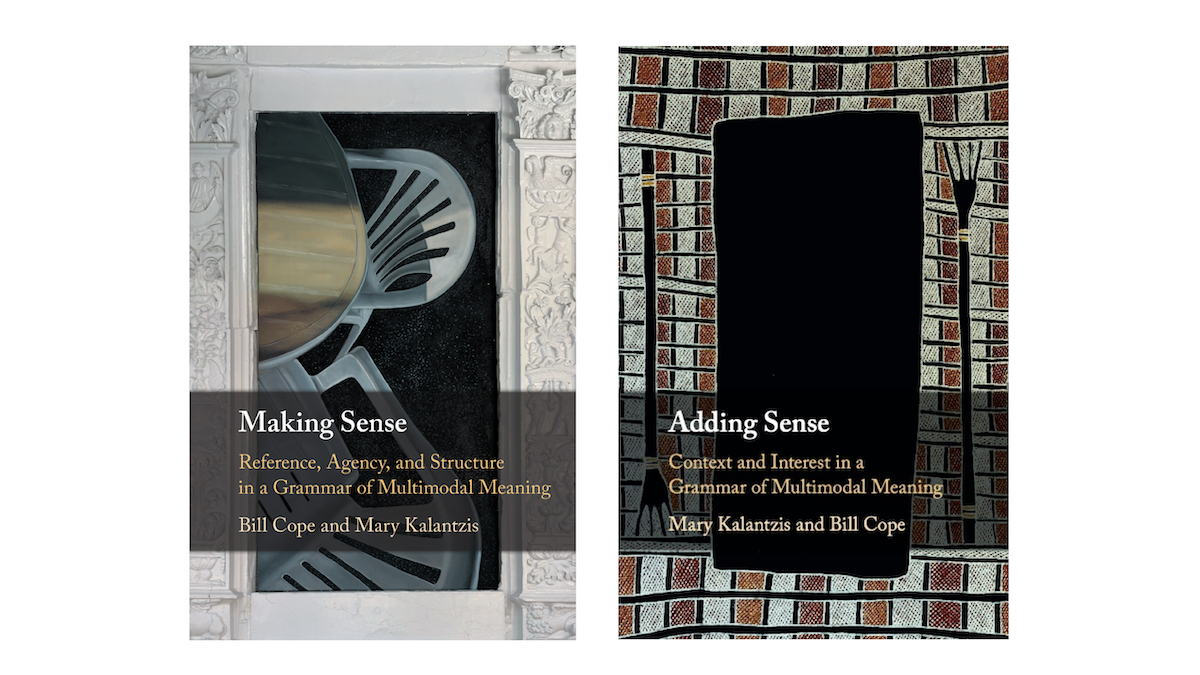For regular posts of extracts from the books, videos and other updates, join our CGScholar community or Facebook group.
And listen to our podcast series with Daniel Shea.

Cope and Kalantzis outline their transpositional grammar in two volumes, published by Cambridge University Press.
Now available in paperback and e-book formats. Take this link for 20% discount on the paperback, entering the discount code LING3722
Making Sense: Reference, Agency and Structure in a Grammar of Multimodal Meaning
"This is a book that could only be written by authors such as Cope and Kalantzis, who have themselves lived through the sheer breadth of the lines of development they bring to readers' attention, making connections and leaps which would in the normal, more circumscribed, business of everyday research rarely occur." John A. Bateman, Journal of Pragmatics.
"Just as Moby Dick was not really a story about a whale but a story about everything, Making Sense is not really a theory of meaning, but a theory of everything and a whale of a story to boot." James Paul Gee, Regents' Professor and Mary Lou Fulton Presidential Professor of Literacy Studies, Arizona State University.
Adding Sense: Context and Interest in a Grammar of Multimodal Meaning
"Adding Sense is a unique book, focusing on 'sense' from many theoretical angles, including anthropology, semiotics, and psychology. It is as brilliant as it is comprehensive, showing how we must access various sources of insight to complete the picture of what sense is." Marcel Danesi, Professor of Semiotics and Linguistic Anthropology, University of Toronto.
- Also available in CGScholar Learning Module format: Meaning Patterns: An Introduction to Semiotics and the Interpretation of Meanings in Education and the Social Sciences
* * *
"We do not want to formalize structures of meaning
into categorical objects, frozen for the moment of analysis. Rather, we
are interested in the patterns of their becoming, what they have been
and what they are begging yet to become." (Adding Sense, §0.4)
Transposition
Transpositional grammar describes and analyzes movement in meaning across and between its different meaning-forms: text, image, space, object, body, sound and speech. Meanings can be expressed in all of these meaning-forms, though never in quite the same way—hence: multimodality and the transposition of meanings from form to form.
Across all of these meaning-forms and within their multimodal manifestations, any and every meaning expresses five meaning-functions: reference, agency, structure, context, and interest. In this functional perspective, meanings are always on the move, as we shift our attention from one meaning-function to another, and within each function where meanings are ever-ready and always-impatient to move.
Transpositional grammar is an account of meanings that, in their very nature, are always in a process of transformation.
Meaning-Forms and Multimodality
This a grammar of constant movement. Not only is it multimodal in scope. It also suggests an alternative to categorically rigid and language-centered understandings of meaning. A transpositional grammar recognizes that meanings shift backwards and forwards across and between different forms, the one form complementing the other for the peculiarities of its media—its affordances.
Meaning-Functions
Meanings also shift functionally. A singular instance is always about to become a countable concept. A self-centered “I” is always about to become an empathetic “other.” Entities can be understood in terms of the actions by which they have been constituted and the ways in which, any moment, they are likely to act. In these ways and many others like them, all the meanings in the world are always on the move. A transpositional grammar sets out to capture the impatience of these movements, and their possible directions.
Grammar
"A grammar is a resource for meaning, the critical functioning
semiotic by means of which we pursue our everyday life. It therefore
embodies a theory of everyday life; otherwise it cannot function in this
way... A grammar is a theory of human experience." M.A.K. Halliday
This is a grammar of everyday life. In our old-fashioned, schoolish
understandings, “grammar” was the syntax of language, rules for correct
speaking and writing. Following Michael Halliday’s suggestion, we want
to use this word in a wider sense, to develop an account of grammar as
patterns in meaning.
Our reasons expanding the definition of grammar are twofold. First, the
meanings of speaking and writing have never made sense outside a wider
understanding of the relations of text and speech to image, sound, body,
space, and object. It makes even less sense to make such separations
today, in an era of pervasive digital media where these forms of meaning
are so profoundly overlaid. This phenomenon we call “multimodality.”
Transposition is the activity of reframing meaning in one form, then
another.
The second reason for our broader definition of grammar is to challenge
the very mode of operation of most grammars, and, more generally,
structuralist approaches to linguistics and semiotics which classify and
categorize meanings. Eschewing the neat separations, we want to say
that meanings are always traveling on journeys of change. We call this
movement “functional transposition.”
